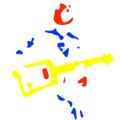
You'll need know, or at least be able to figure out, the names of the notes on the 6 string tab. You can use your knowledge of intervals to do this, saves you remembering everything, there's just too much if you're not using them regularly. There's also a simple method that uses all of the natural notes, the notes in the C major scale.
The image here gives you the note names of the first 5 frets. The trick now is to recognise the patterns so you can find the rest of them yourself!
The natural notes
Notice firstly that most of the natural notes (no sharps or flats) are two frets apart, the exceptions are E/F and B/C. That's all you need to know to figure out the rest. Unless you're playing an E or a B, the next note is two frets away. Easy.
Sharps and flats
Notes that aren't on this diagram have to be named as well and we do that using sharp (#) and flat (b) symbols. The # symbol means the note is one fret higher than the letter name and the b means that it's one fret lower. So the note between G and A can be called either G# or Ab depending on the key you're in. The note between C and D will be either C# or Dd again depending on the key.
Next
Now see if you can figure out the rest! A few hints:
- See that the note on the 6th string 5th fret is the same as the open 5th string, it's an A. That means the note two frets up on the 6th string (the 7th fret) must be a B.
- Look to the on that 5th string what's next? The C one more fret up. Same deal for the B on the 6th string, one fret up to the C.
- Then it's 2 frets up to the D which is the same as the open 4th string so we go bac there to see whats next.
